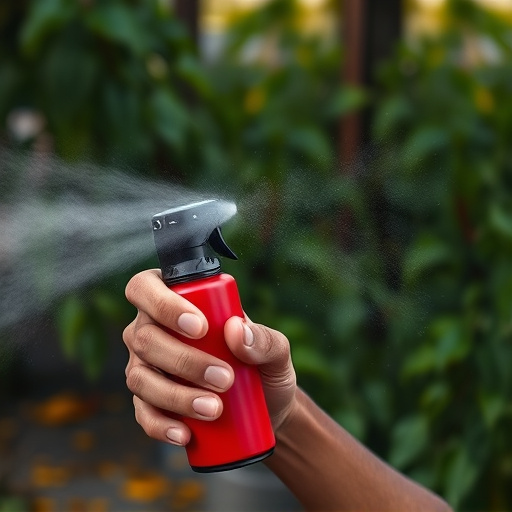Storing pepper spray correctly is vital for maximizing its effectiveness in law enforcement. OC spray, CN/CS gas agents require climate-controlled environments, minimal sunlight, and secure containers to maintain potency. Strict temperature controls, strategic placement, inventory checks ensure swift access during disturbances while minimizing collateral damage and adhering to legal guidelines. Comprehensive training and safe storage practices are key to responsible deployment, balancing public order with individual rights.
“Riot control agents, particularly pepper spray, are powerful tools in law enforcement, offering a non-lethal means to manage chaotic situations. This comprehensive guide explores the multifaceted world of riot control agents, focusing on storing pepper spray effectively. From understanding various types and deployment strategies to legal considerations and officer training, we delve into best practices for maximizing the effectiveness of pepper spray in real-world scenarios, ensuring safety and control.”
- Understanding Pepper Spray: Types and Applications
- Storing Pepper Spray: Best Practices for Law Enforcement
- Effective Deployment Strategies: Maximizing Impact
- Legal Considerations: Use and Liability Issues
- Training and Safety: Preparing Officers for Response
Understanding Pepper Spray: Types and Applications
Pepper spray, a common riot control agent, is a powerful tool used by law enforcement to subdue and disrupt crowds during civil unrest or high-risk situations. It works by causing temporary blindness, coughing, and respiratory distress in those affected, allowing officers to gain control and ensure public safety. Understanding the different types of pepper spray and their applications is crucial for effective deployment and storage.
There are various types of pepper spray available, each with specific formulations designed for distinct purposes. Oleoresin capsicum (OC) spray, the most common type, is derived from chili peppers and offers a broad spectrum of protection. For more specialized scenarios, agent spray containing active ingredients like CN (chloroacetonitrile) or CS (chlorkation) gas can be employed. The choice of pepper spray depends on factors such as crowd size, environmental conditions, and the level of resistance anticipated. Proper storing of pepper spray is vital to maintain its effectiveness. This includes keeping it in a cool, dry place, away from direct sunlight, and ensuring the container remains sealed to prevent degradation due to moisture or oxidation, thereby maximizing its potency when needed.
Storing Pepper Spray: Best Practices for Law Enforcement
To ensure pepper spray remains effective, law enforcement agencies should adhere to best practices for storage. One crucial factor is temperature control; extreme heat or cold can degrade the chemical composition of the spray. Storing pepper spray in a climate-controlled environment, such as a secure armory or designated locker room, maintains its potency. Additionally, proper ventilation is essential to prevent buildup of volatile gases that could diminish the spray’s intensity.
Another important practice involves keeping pepper spray out of direct sunlight and away from heat sources like radiators or heating vents. Agitation during transport should be minimized; frequent handling or rough handling might introduce contaminants or cause the canister to become damaged, compromising its integrity. Secure storage in locked containers further protects the spray from unauthorized access and potential tampering, ensuring it remains a reliable tool for law enforcement when needed.
Effective Deployment Strategies: Maximizing Impact
Effective deployment strategies are crucial in maximizing the impact of riot control agents, such as pepper spray. Law enforcement agencies should prioritize proper storage and handling procedures to ensure these substances remain potent and effective when needed. Storing pepper spray correctly involves maintaining optimal conditions, including controlled temperatures and minimal exposure to light or moisture, which can degrade its chemical composition.
Strategic placement of pepper spray in easily accessible yet secure locations is key. During disturbances, quick deployment ensures its maximum impact on dispersing crowds while minimizing harm to bystanders. Additionally, regular maintenance and inventory checks help keep track of stock levels and identify any potential issues, ensuring a consistent supply during critical situations.
Legal Considerations: Use and Liability Issues
The use of riot control agents, such as pepper spray, by law enforcement is governed by a complex web of legal considerations and regulations. While these agents are powerful tools in crowd control and maintaining public safety, their application must adhere to strict protocols to protect both officers and civilians. One critical aspect is the proper storage of pepper spray to ensure its maximum effectiveness and longevity.
Liability issues surrounding riot control agent use have led to comprehensive guidelines on their deployment. Law enforcement agencies must train their personnel extensively on when and how to use these substances, ensuring minimal harm and adhering to legal boundaries. Storing pepper spray in designated, secure areas is essential to prevent unauthorized access and ensure its availability when needed. This careful management of riot control agents balances the need for public order with the rights of individuals, fostering a fair and accountable law enforcement system.
Training and Safety: Preparing Officers for Response
Training and safety are paramount when it comes to riot control agent deployment by law enforcement. Officers require specialized instruction to handle these powerful tools effectively while minimizing risks to themselves and bystanders. The process involves learning proper usage techniques, understanding the unique properties of each agent, and practicing in simulated scenarios.
A crucial aspect of this preparation is storing pepper spray correctly for maximum effectiveness. It necessitates following best practices, such as keeping containers in secure, dedicated locations, ensuring they remain sealed until use, and regularly inspecting them for damage or expiration dates. These measures help maintain the integrity of the agent, guaranteeing its potency when needed most during high-pressure situations.
Pepper spray is a valuable tool in law enforcement, but its effectiveness depends on proper storage and deployment. By understanding the different types, storing it safely according to best practices, and training officers in effective deployment strategies, law enforcement agencies can maximize the impact of this agent while mitigating potential liability issues. These measures ensure that pepper spray remains a reliable tool for maintaining public safety.
